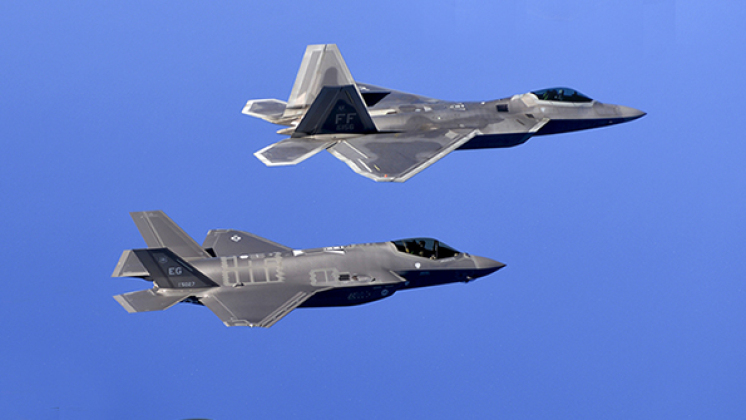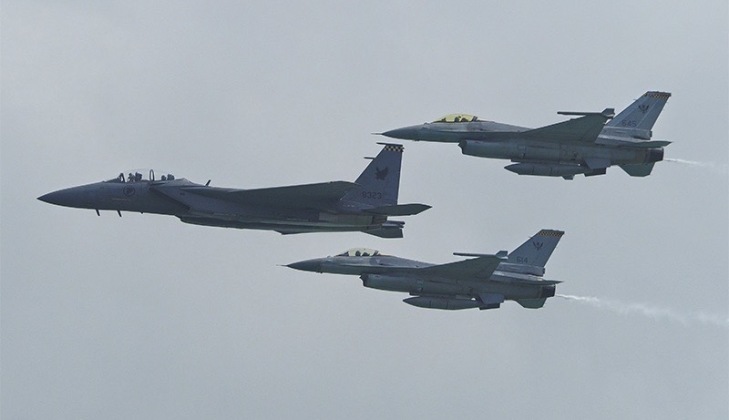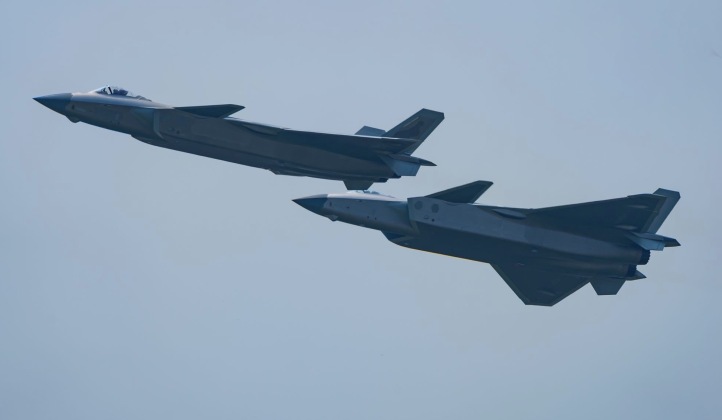The F-22A Raptor and F-35A Lightning II were designed to be fielded in parallel as complementary fifth generation fighters in the United States Air Force, replacing the respective F-15 and F-16 of the fourth generation with the former being a heavyweight twin engine designs fielded in smaller numbers, and the latter a light single engine jet that would form the bulk of the fleet. With the F-22 seeing orders to terminate production given less than four years after the fighter entered service, resulting in only 187 airframes being produced and a failure to replace the older F-15, which is still in production today, the F-35 is today the only post fourth generation fighter in production anywhere in the Western world. Where the F-22 was intended to be a much higher end aircraft with overall superior capabilities, issues with the design have forced the Pentagon to plan for its retirement decades early while F-35s and F-15s, initially intended to be far surpassed by the F-22, remain on production lines. Although the F-35 is less stealthy than the F-22 and has a very far poorer flight performance, a number of other advantages have led it to increasingly be seen as the preferable fighter not only from a logistics and maintenance perspective, but also due to its combat performance as its avionics increasingly advance to leave the F-22 behind.

Interviewed on the F-35 and F-22, U.S. Air Force fighter pilot Rick Scheff observed that he would choose the “F-35, no doubt” if going into combat even if against a higher end adversary such as Russia, China or North Korea. “The Raptor is about as cool as it gets, and it is the greatest air superiority fighter the world has ever seen, but like the F-15C that it was originally designed to replace it is an airplane without a real mission in modern conflict. When was the last time an American fighter killed another fighter in an air to air engagement? Go look it up, I’ll wait,” he stated. The date was in fact 2017, far more recently than most realised, when a U.S. Navy F-18E/F shot down a Syrian Su-22 strike fighter, although aside from that single incident air to air combat incidents with manned fighters have been few and far between in the past three decades. Scheff further elaborated:
“It is cool to think about WWII/Korea’Vietnam and the great dogfights of history, and believe me I wish I had been flying then, but that just isn’t the modern battlefield. None of America’s conflicts feature pitched battles against technologically modern opponents. Even if somehow a real war against a modern opponent kicked off, the days of within visual range fighting would be over. There is a place for visual identification and actual fighter manoeuvring right now, but in a no kidding war against Russia or China there wouldn’t be. We would be killing them from as far away as we possibly could. With that in mind, the 35’s sensor fusion and ability to carry ordinance externally is more valuable than the 22’s ability to turn corners in style.
Additionally, the real role of modern fighters involves an air to ground component. CAS (Close Air Support) and SEAD (Suppression of Enemy Air Defences), and old-fashioned dropping of bombs are the real reasons to have modern fighter jets. The ability to fight in and fight out (multirole) is an added bonus, but at the end of the day wars are won by killing people on the ground and breaking their stuff, so you want fighters that can A- kill people and break their stuff, and 2- make it safe for bombers and attack jets/helicopters to kill people and break their stuff. The Raptor has some limited ability to do this, but the 35 was designed to do this. In the same way the Viper [F-16] is fundamentally superior to the F-15C, the 35 is fundamentally superior to the 22. Multirole aircraft are designed with the mission in mind. Air to Air airplanes are designed to fight a war that we don’t fight, and mostly function as high-speed cheerleaders. At some point the question of which you’d rather fly boils down to this: would you rather be the world’s most badass high-speed cheerleader, or would you rather do the job? The 35 does the job.”

Scheff notably highlighted that the primary threat to American aircraft has since the end of the Cold War come from ground based air defence systems rather than fighter aircraft. This may well have influenced the F-35 to focus heavily on air to ground missions, hence its program name the Joint Strike Fighter, where by contrast its predecessor the F-16 developed during the 1960s and 1970s was intended primarily for air to air roles at a time when Soviet control of the air was a significant possibility. The F-16 was only later repurposed into a fighter primarily used for air to ground missions. The 1990s saw the Russian Air Force contract to a small fraction of its prior size, and clients across the world lose access to high performance fighters on favourable terms ranging from Iraq and Syria to North Korea and Cuba. Furthermore, the sharp contraction of the Russian defence sector meant promising next generation programs such as the MiG 1.42 fighter and MiG 701 interceptor were terminated while other less ambitious ones such as the Su-27M, which later became the Su-35, entered service decades later than planned. Russian air defence technologies by contrast continued to receive considerable investment even during the 1990s, and are considered a far more prevalent challenge as they have been relied on by Russia, North Korea, Iran, Syria and other potential adversaries to compensate for their inferior air power in the 21st century relative to the Cold War era.

The argument made by Scheff in favour of focusing on strike rather than air superiority fighters remains somewhat tenuous, while holding far more true in the 21st century than in the Cold War era, is somewhat tenuous when considering that the United States has been surpassed by China not only in the size of its economy but also in the scale of its research and development in key areas leading some in Washington to warn that China could field the world’s first sixth generation fighters before America can. China today has the world’s only fifth generation fighter in production and fielded at squadron level strength outside the U.S., the J-20, which has avionics considered on par with the F-35 but uses a twin engine heavyweight airframe built for air superiority like the F-22. U.S. Air Force officials have expressed admiration for the fighter’s capabilities and its evolution in operations since it was first delivered to China’s armed forces in 2016. While Russia’s very long delays in developing its Su-57 program, which replaced the prior MiG 1.42 program in development in the 2000s, having potentially taken it out of competition in future generations, Chinese combat aviation poses a very real challenge to American air superiority which means fighters like the F-22, albeit more capable and less problematic ones which the Air Force hopes its sixth generation NGAD fighter will be, shall be in high demand. Thus while the need for air superiority fighters may well remain much lower than in the Cold War era, Chinese advances and the high chance that China will proliferate its high performance fighters in the coming decades means this trend could well be reversed in future.
